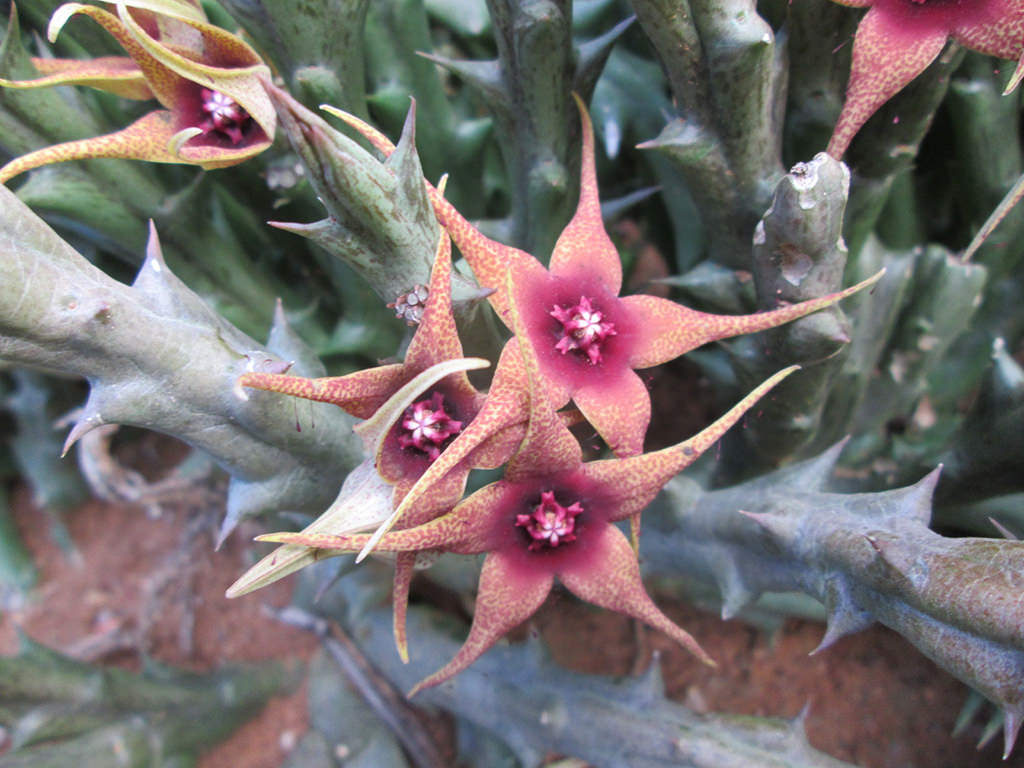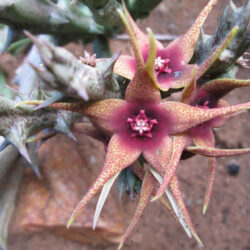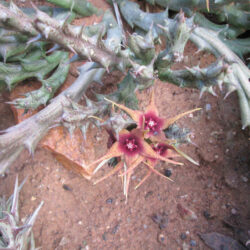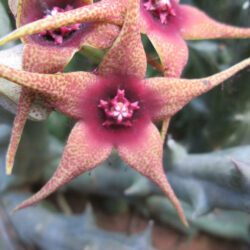Orbea caudata was first described as Caralluma caudata by Nicholas Edward Brown in 1903.
Scientific Name
Orbea caudata (N.E.Br.) Bruyns
Synonym(s)
Caralluma caudata, Ceropegia caudata, Orbea caudata subsp. caudata, Orbeopsis caudata
Scientific Classification
Family: Apocynaceae
Subfamily: Asclepiadoideae
Tribe: Ceropegieae
Subtribe: Stapeliinae
Genus: Orbea
Etymology
The specific epithet "caudata (kaw-DAH-tuh)" means " tailed, caudate (having or provided with a tail)" and refers to the shape of the corolla lobes.
Origin
Orbea caudata is native to Tanzania, Zambia, Malawi, Mozambique, Angola, Namibia, Zimbabwe, and Botswana. It grows in shallow soils on granite rock at elevations between 1,970 and 5,250 feet (600 and 1,600 m).
Description
Orbea caudata, formerly known as Caralluma caudata, is a small succulent that forms clumps of fleshy stems with tubercles arranged loosely into four rows with a groove between them. The tubercles are upcurved or spreading and can reach up to 0.4 inches (1 cm) long, tapering into a conical sharp tooth. The stems are erect, ascending, or decumbent and can grow up to 4 inches (10 cm) long and up to 0.4 inches (1 cm) thick, excluding teeth. They are greyish-green with dark green to purple-brown mottling.
The flowers are star-shaped, deeply five-lobed, up to 3.6 inches (9 cm) in diameter, and appear near the base of the young stems in late summer or fall. The corolla is yellow, mottled with purple, sometimes almost completely dark purple, with lobes often fringed with purple, paddle-shaped hairs.

How to Grow and Care for Orbea caudata
Light: Orbea caudata thrives in full sun or partial shade during the hottest summer days. Too much sun causes the stems to develop a protective pigmentation or get sunburned. Not enough light leads to weak, thin stems and fewer flowers. Indoors, place the plant near a sunny window in your home.
Soil: The right soil is crucial to growing a healthy plant. Use commercial soil for succulents, or prepare your own mix with 50 to 70 % mineral grit, such as coarse sand, pumice, or perlite.
Temperature: This plant thrives in warm outdoor environments but does not like winter cold and should remain moderately dry and warm during its winter dormancy. Orbea caudata grows best in USDA Plant Hardiness Zones 9b to 11b, with average minimum winter temperatures ranging from 25 to 50 °F (-3.9 to 10 °C).
Watering: It has typical watering needs for a succulent. During the growing season, water your plant thoroughly and allow the soil to dry before watering again. The plant goes dormant in winter and needs almost no water, about once a month.
Fertilizing: To keep it thriving, fertilizing during the growing season is a good idea. Feed with water-soluble fertilizer diluted to half the recommended strength.
Repotting: Orbea caudata will benefit from fresh potting soil every 2 or 3 years. Repot it in spring, just before the growing season starts. Pick a container with drainage holes.
Propagation: The best way to propagate this succulent is from stem cuttings. It is also easy to grow from seeds. Take cuttings during the growing season to ensure good rooting. Sow the seeds in spring.
Learn more at How to Grow and Care for Stapelia.
Toxicity of Orbea caudata
Orbea caudata has no toxic effects reported. It is safe around pets and humans.
Subspecies of Orbea caudata
Links
- Back to genus Orbea
- Succupedia: Browse succulents by Scientific Name, Common Name, Genus, Family, USDA Hardiness Zone, Origin, or cacti by Genus
Photo Gallery
Click on a photo to see a larger version.


